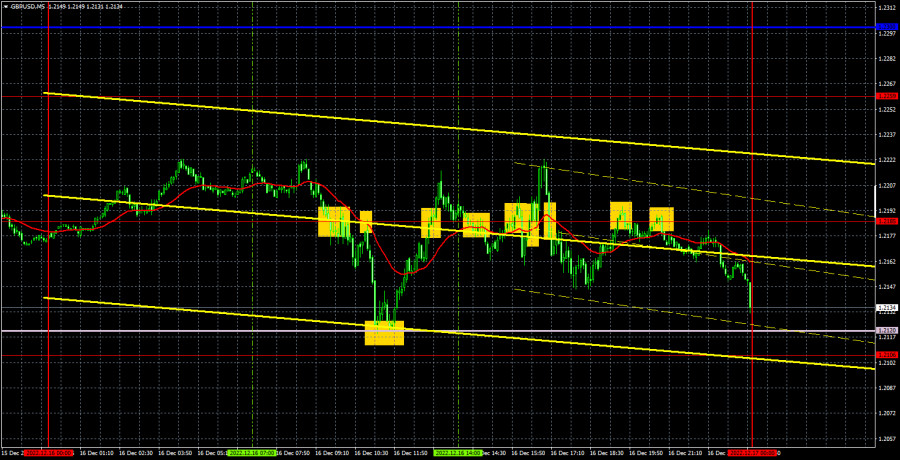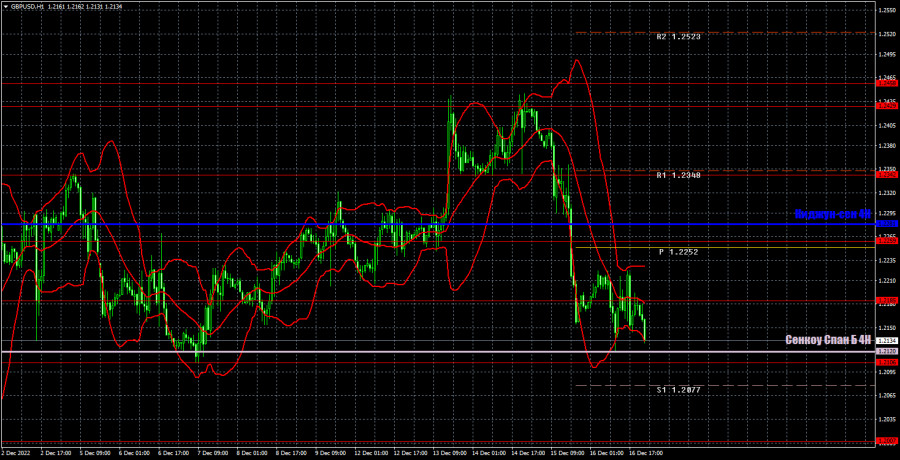

GBP/USD continued to move down on Friday. In addition to business activity indices in the manufacturing and services sectors in the UK and the US, there was a report on British retail sales, which turned out to be weaker than forecast. So overall, the pound fell logically, but at the same time, not all the reports were worked out logically. During the day, there were many reversals, and the whole movement was more like a flat, than a downtrend. The week ended near the Senkou Span B line, which the bears will have to overcome this week if they are ready for a further decline. Failure to overcome this line could trigger the uptrend of the last two and a half months.
There were a lot of trade signals on the 5-minute chart. The first sell signal near 1.2185 seemed profitable and was even duplicated by a rebound from the same level from below. The price fell to the Senkou Span B line and bounced from it, forming a buy signal. Therefore, it was possible to earn about 40 pips on the first trade. The buy signal was also profitable, because the pair returned to 1.2185 and settled above it. However, later the pair fell lower, where long positions should have been closed. The profit was another 40 pips. The new sell signal turned out to be a false one, which resulted in the loss of about 30 pips. The next buy signal was also negative, but Stop Loss broke even. All subsequent signals should not be processed, and the day ended with the total profit.
COT report
The latest COT report showed a decrease in bearish sentiment. During the given period, non-commercial traders opened 3,500 long positions and 1,000 short positions. The net position grew by about 2,500. This figure has been on the rise for several months. Nevertheless, sentiment remains bearish, and GBP/USD is on the rise for no reason. We assume that the pair may well resume the downtrend soon. Notably, both GBP/USD and EUR/USD now show practically identical movement. However, the net position on EUR/USD is positive and negative on GBP/USD. Non-commercial traders now hold 58,000 short positions and 32,000 long ones. The gap between them is still wide. As for the total number of open longs and shorts, the bulls have a 5,000 advantage here. Technical factors indicate that the pound may move in an uptrend in the long term. At the same time, fundamental and geopolitical factors signal that the currency is unlikely to strengthen significantly.
H1 chart of GBP/USD
GBP/USD finally dropped below the Kijun-Sen line on the one-hour chart, but there is another important line on the way. The Senkou Span B might keep the uptrend, especially since the market has only been set up for buying just recently. If it crosses the Senkou Span B line, then we can count on a strong correction, which we have been waiting for a long time. On Monday, the pair may trade at the following levels: 1.1874, 1.1974-1.2007, 1.2106, 1.2185, 1.2259, 1.2342, 1.2429-1.2458. The Senkou Span B (1.2120) and Kijun Sen (1.2281) lines may also generate signals. Pullbacks and breakouts through these lines may produce signals as well. A Stop Loss order should be set at the breakeven point after the price passes 20 pips in the right direction. Ichimoku indicator lines may move during the day, which should be taken into account when determining trading signals. In addition, the chart does illustrate support and resistance levels, which could be used to lock in profits. There are no important events planned for Monday, neither in the UK, nor in the US. The key point will be the Senkou Span B line.
What we see on the trading charts:Price levels of support and resistance are thick red lines, near which the movement may end. They do not provide trading signals.
The Kijun-sen and Senkou Span B lines are the lines of the Ichimoku indicator, moved to the one-hour chart from the 4-hour one. They are strong lines.
Extreme levels are thin red lines from which the price bounced earlier. They provide trading signals.
Yellow lines are trend lines, trend channels, and any other technical patterns.
Indicator 1 on the COT charts reflects the net position size of each category of traders.
Indicator 2 on the COT charts reflects the net position size for the non-commercial group.